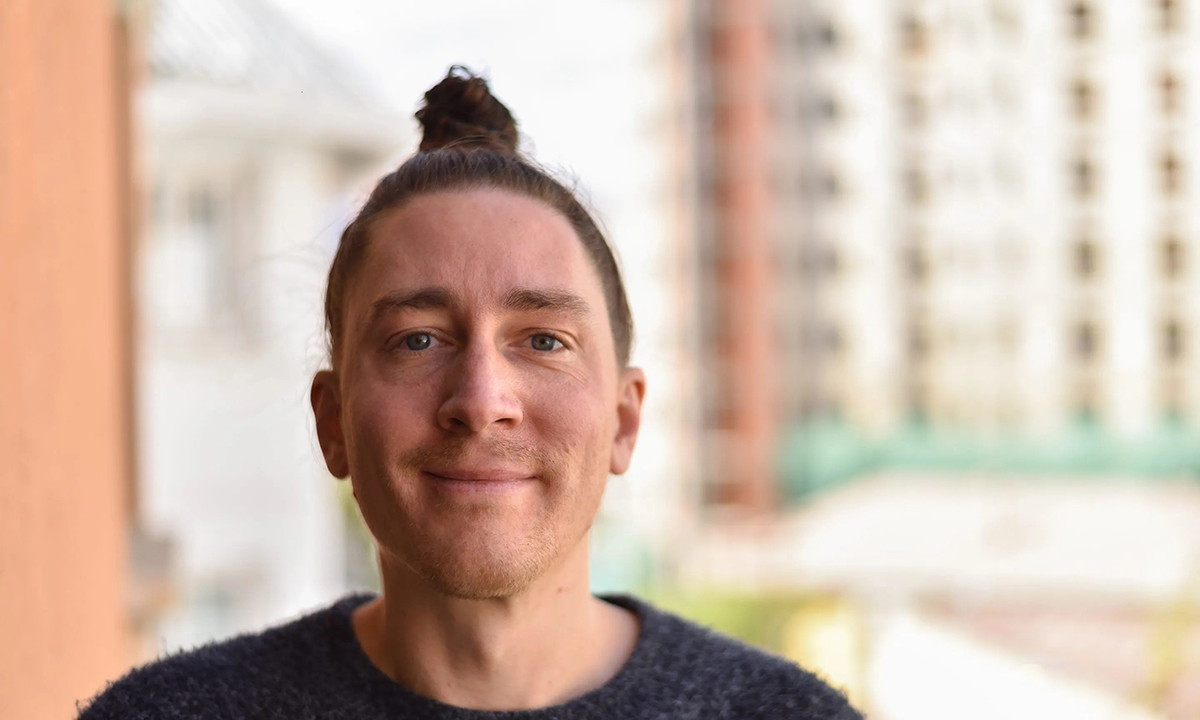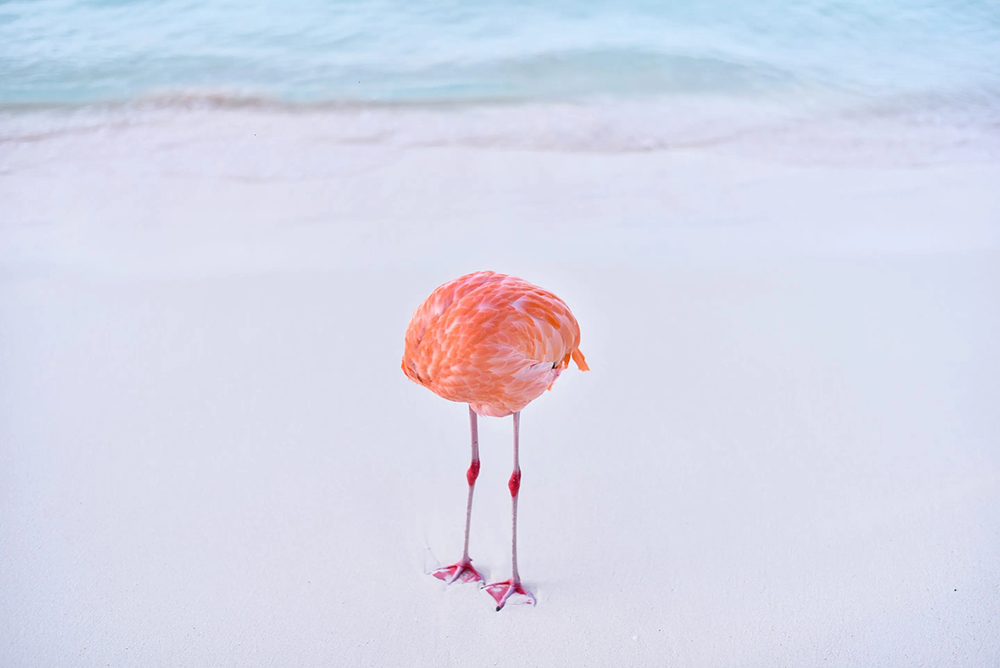
邁爾斯·阿斯特雷是一位跨學科藝術家,他將融合后的寫作與攝影與藝術活動相結合。這一舉動源于他于2012年開始的一場慢節(jié)奏沉浸式世界之旅。
作為一名作家和攝影師,人工智能生成內容的影響對我來說至少是兩個層面的。不過,我倒是不那么擔心這一顛覆性的技術可能對自身工作帶來的影響。我已經構建了個人專屬創(chuàng)意語言,這一點機器基本是不會的。我擔心的是,結構性的社會變化可能會讓生計、職業(yè)、工業(yè)以及民主基石在一夜之間消失。
別緊張,我并不是在預言世界末日,也不是在妖魔化人工智能。不過,我的確認為我們有必要盡快將公眾有關人工智能的高談闊論轉化為實際行動。我們并非處于浪潮之上,而是深陷于深海之中,因此沒有退路可言。
最近,我為自己的作品(下圖)報名參加了1839攝影獎(1839 Awards),角逐人工智能組獎項。這是一個知名的國際攝影大賽。反常之處:這幅看似無頭的火烈鳥是一張真實拍攝的照片,只不過這只鳥在忙著梳理腹部的羽毛罷了,因此頸部被腹部遮住了。我覺得,如果這幅報名作品能夠俘獲賽事知名評審委員會的芳心,那么我便能證明:人類制作的內容并沒有失去其相關性;大自然及其人類解讀者依然可以打敗機器;以及創(chuàng)意和情感并非一串數(shù)字那么簡單。

經過評審委員會評審,我的照片與少數(shù)幾張“真正”的人工智能生成圖片最終入圍,并角逐兩個獎項:評審選擇獎以及公眾投票獎。最終,這幅作品說服了評委和觀眾,于上周同時贏得了這兩個獎項。據我所知,這幅照片是第一張贏得人工智能大獎的真實照片。
即便如此,那又能怎樣?
什么是真,什么是非真?
當然,我對于誤導評委感到不安,但我覺得他們是專業(yè)人士,他們也應該會意識到,此次對人工智能的發(fā)難及其道德層面的影響超過了欺騙觀眾這一不道德行為。當然,具有諷刺意味的是,人工智能其實也在欺騙觀眾。因此,這也是我最初決定采取這個不光彩手段的原因:近些年來,多張人工智能生成的照片在它們本不應該參賽的國際攝影大賽中奪得桂冠,成為了國際討論熱點。這一事實也凸顯了該技術能力的不斷增長。
在關注這些熱點之余,我意識到我可以反其道而行之,做一件只有人類才可以做的事情。有人可能會說,人工智能給我?guī)砹遂`感,但很快就會有人回應說,這些機器依然是人類在操控,將人工智能當做是其視覺心腹。事實在于,這一理念確實說服了一批行業(yè)專業(yè)人士,包括《紐約時報》(New York Times)、費頓出版社(Phaidon Press)、華蓋創(chuàng)意(Getty Images)、巴黎蓬皮杜藝術中心(Centre Pompidou)、佳士得(Christie’s)和馬多克斯畫廊(Maddox Gallery)的成員。這個事實也說明了一些問題,我覺得應該按照以下順序排列:
? 自然依然超越機器。
? 我們的大腦還沒有適應新常態(tài)。
? 人們已經無法分辨人工智能圖片與真實照片。
第一個是毋庸置疑的。我現(xiàn)在來解釋剩下的兩個。
我認為這件事不應該責怪評審。事實上,他們并沒有拆穿我的小伎倆并不是說他們專業(yè)不強,而是在于認知偏差。他們并沒有想到有人會用真實照片報名參加人工智能組別比賽,因此沒有做任何準備。誰又能想到此事?
然而,問題就出在這里:同樣,我們作為一個社會,也壓根沒有準備去質疑我們遇到的每一個圖片、音頻文件或視頻,因為在歷史上我們無需這樣做,亦或我們不應該這樣做。可能是因為質疑眼前所有錯誤的事情和任何人,是一件可悲的事情。然而,如果我們希望走在AI前面,那么我們的批判性思考就必須與AI的光速發(fā)展進行角逐,這是我們每個人都應該承擔的責任。
至于那些與現(xiàn)實沒有多大區(qū)別的人工智能照片,我這么做背后的用意與柏林藝術家鮑里斯?艾爾達格森去年參賽的照片沒有太大的區(qū)別,當時,他用一張人工智能生成的圖片贏得了索尼全球攝影大賽的創(chuàng)意組獎項,只不過他是反其道而行之,相當于換湯不換藥。人們目前還沒有為應對人工智能的各種影響做好準備。
誠然,如果人工智能能得到合理的利用,它甚至有助于創(chuàng)意的提升。它確實在幫助艾爾達格森進行創(chuàng)作。然而,人工智能也會讓很多創(chuàng)意徒有其表,取決于創(chuàng)意人士如何運用,以及我們會為此推行什么樣的制度框架。一些創(chuàng)意人士已經在利用人工智能來外包一些瑣碎的任務,并釋放相關資源,讓自己抽身從事真正熱愛的項目。其他創(chuàng)意人士可能已經失去了不少機會,因為在了解人工智能生成內容的雇主眼中,他們的作品看起來流于形式。
不過,這種夸張的、非黑即白的場景中存在著很多灰色空間。例如,如果初創(chuàng)企業(yè)資金緊張,不愿意聘請圖形設計師,也可以使用人工智能來創(chuàng)作免費的公司標志。因此,這位圖形設計師就因此而失去了一份工作。同一家初創(chuàng)企業(yè)可能還會用人工智能來生成其博客的通用圖庫,同樣的內容如果由圖庫攝影師完成的話得花不少錢。不過,這位圖庫攝影師可能已經在使用AI,以更低的價格來制作其內容。這件事情十分復雜。一旦我們開始討論那些欺騙觀眾的具體內容,無論是有意還是無意,情形就會變得更復雜。例如,AI可能永遠無法取代的便是有新聞價值活動的真實照片。不過,AI可以制造假照片,來虛構電腦之外從未發(fā)生過的新聞。
人工智能是利大還是弊大?
科技本身沒有好壞之分,天生就是如此。真正決定其好壞的是人類使用科技的方式。如果我們沒有在廣島扔原子彈,而是利用其來改變靠近地球行星的軌跡,我們可能會將其稱為神圣炸彈。在推動人類進步或毀滅人類方面,人工智能與其他科技沒有任何區(qū)別。
然而,既然我們未能利用好其顛覆性的前任——社交媒體,那么面對新一輪的變革,我們應該先發(fā)制人。不過別誤會,我喜歡變革。我的整個人生都處于變化之中。不過,變化需要適應。當社交媒體讓互聯(lián)網發(fā)生巨變之時,它最初是通過連接全球各地的民眾,然后推動了阿拉伯之春這類革命。非常好!不過在不久之后,它便成為了散播虛假新聞的元兇,傷害了選舉和民主。
人工智能有望讓這一切看起來就像是孩子們的惡作劇,相當于把大規(guī)模誤導武器放到了任何需要它的人的手中,而且無需任何背景調查。如果我們希望獲得標記人工智能生成內容的能力,那么我們可能有必要為其貼上標簽。這一重擔應由政府和私營領域來肩負,而且其重要性不亞于民間以及個人在批判性思維以及質疑司空見慣事情方面所應肩負的責任。我們必須引導年輕人去開展這件事情。
反響與深意
人工智能正在重塑數(shù)字領域的格局,受此影響,有關人工智能對內容未來及其背后創(chuàng)作者影響的討論也是愈發(fā)激烈,這些創(chuàng)作者包括藝術家、記者和圖形設計師。由此看來,我的惡作劇算是觸碰到了敏感點。全球各地的新聞媒體紛紛報道此事,而且好的老社交媒體對其進行了放大。鋪天蓋地的積極反饋令我應接不暇。這個做法及其背后的動機獲得了大量支持,不過,最令我感到驚訝和自愧不如的莫過于賽事組織方對此事的反饋。
在我告知賽事舉辦方“火烈鳥”照片的真實情形之后,考慮到需要公平對待其他使用AI圖片的參賽選手,他們取消了火烈鳥照片的參賽資格。聯(lián)合創(chuàng)始人兼總監(jiān)莉莉·費爾曼給我發(fā)了一封郵件,并評論說,她非常欣賞此舉深刻的用意,也肯定了相關聲明的重要性和及時性。
她寫到:“我們希望,此舉能讓眾多擔心人工智能的攝影師增強這一方面的意識,并為他們帶來希望。”
就我自己而言,我希望我的勝利能成為業(yè)界眾多創(chuàng)意人士的勝利,也希望那些擔心人工智能的人士能真正意識到這一點。人工智能技術將常伴我們左右,因此我希望人們能夠以一種造福眾人的方式來適應它,采用它。(財富中文網)
Fortune.com上評論文章中表達的觀點僅代表作者個人觀點,并不代表《財富》雜志的觀點和立場。
譯者:馮豐
審校:夏林
邁爾斯·阿斯特雷是一位跨學科藝術家,他將融合后的寫作與攝影與藝術活動相結合。這一舉動源于他于2012年開始的一場慢節(jié)奏沉浸式世界之旅。
作為一名作家和攝影師,人工智能生成內容的影響對我來說至少是兩個層面的。不過,我倒是不那么擔心這一顛覆性的技術可能對自身工作帶來的影響。我已經構建了個人專屬創(chuàng)意語言,這一點機器基本是不會的。我擔心的是,結構性的社會變化可能會讓生計、職業(yè)、工業(yè)以及民主基石在一夜之間消失。
別緊張,我并不是在預言世界末日,也不是在妖魔化人工智能。不過,我的確認為我們有必要盡快將公眾有關人工智能的高談闊論轉化為實際行動。我們并非處于浪潮之上,而是深陷于深海之中,因此沒有退路可言。
最近,我為自己的作品(下圖)報名參加了1839攝影獎(1839 Awards),角逐人工智能組獎項。這是一個知名的國際攝影大賽。反常之處:這幅看似無頭的火烈鳥是一張真實拍攝的照片,只不過這只鳥在忙著梳理腹部的羽毛罷了,因此頸部被腹部遮住了。我覺得,如果這幅報名作品能夠俘獲賽事知名評審委員會的芳心,那么我便能證明:人類制作的內容并沒有失去其相關性;大自然及其人類解讀者依然可以打敗機器;以及創(chuàng)意和情感并非一串數(shù)字那么簡單。
經過評審委員會評審,我的照片與少數(shù)幾張“真正”的人工智能生成圖片最終入圍,并角逐兩個獎項:評審選擇獎以及公眾投票獎。最終,這幅作品說服了評委和觀眾,于上周同時贏得了這兩個獎項。據我所知,這幅照片是第一張贏得人工智能大獎的真實照片。
即便如此,那又能怎樣?
什么是真,什么是非真?
當然,我對于誤導評委感到不安,但我覺得他們是專業(yè)人士,他們也應該會意識到,此次對人工智能的發(fā)難及其道德層面的影響超過了欺騙觀眾這一不道德行為。當然,具有諷刺意味的是,人工智能其實也在欺騙觀眾。因此,這也是我最初決定采取這個不光彩手段的原因:近些年來,多張人工智能生成的照片在它們本不應該參賽的國際攝影大賽中奪得桂冠,成為了國際討論熱點。這一事實也凸顯了該技術能力的不斷增長。
在關注這些熱點之余,我意識到我可以反其道而行之,做一件只有人類才可以做的事情。有人可能會說,人工智能給我?guī)砹遂`感,但很快就會有人回應說,這些機器依然是人類在操控,將人工智能當做是其視覺心腹。事實在于,這一理念確實說服了一批行業(yè)專業(yè)人士,包括《紐約時報》(New York Times)、費頓出版社(Phaidon Press)、華蓋創(chuàng)意(Getty Images)、巴黎蓬皮杜藝術中心(Centre Pompidou)、佳士得(Christie’s)和馬多克斯畫廊(Maddox Gallery)的成員。這個事實也說明了一些問題,我覺得應該按照以下順序排列:
? 自然依然超越機器。
? 我們的大腦還沒有適應新常態(tài)。
? 人們已經無法分辨人工智能圖片與真實照片。
第一個是毋庸置疑的。我現(xiàn)在來解釋剩下的兩個。
我認為這件事不應該責怪評審。事實上,他們并沒有拆穿我的小伎倆并不是說他們專業(yè)不強,而是在于認知偏差。他們并沒有想到有人會用真實照片報名參加人工智能組別比賽,因此沒有做任何準備。誰又能想到此事?
然而,問題就出在這里:同樣,我們作為一個社會,也壓根沒有準備去質疑我們遇到的每一個圖片、音頻文件或視頻,因為在歷史上我們無需這樣做,亦或我們不應該這樣做。可能是因為質疑眼前所有錯誤的事情和任何人,是一件可悲的事情。然而,如果我們希望走在AI前面,那么我們的批判性思考就必須與AI的光速發(fā)展進行角逐,這是我們每個人都應該承擔的責任。
至于那些與現(xiàn)實沒有多大區(qū)別的人工智能照片,我這么做背后的用意與柏林藝術家鮑里斯?艾爾達格森去年參賽的照片沒有太大的區(qū)別,當時,他用一張人工智能生成的圖片贏得了索尼全球攝影大賽的創(chuàng)意組獎項,只不過他是反其道而行之,相當于換湯不換藥。人們目前還沒有為應對人工智能的各種影響做好準備。
誠然,如果人工智能能得到合理的利用,它甚至有助于創(chuàng)意的提升。它確實在幫助艾爾達格森進行創(chuàng)作。然而,人工智能也會讓很多創(chuàng)意徒有其表,取決于創(chuàng)意人士如何運用,以及我們會為此推行什么樣的制度框架。一些創(chuàng)意人士已經在利用人工智能來外包一些瑣碎的任務,并釋放相關資源,讓自己抽身從事真正熱愛的項目。其他創(chuàng)意人士可能已經失去了不少機會,因為在了解人工智能生成內容的雇主眼中,他們的作品看起來流于形式。
不過,這種夸張的、非黑即白的場景中存在著很多灰色空間。例如,如果初創(chuàng)企業(yè)資金緊張,不愿意聘請圖形設計師,也可以使用人工智能來創(chuàng)作免費的公司標志。因此,這位圖形設計師就因此而失去了一份工作。同一家初創(chuàng)企業(yè)可能還會用人工智能來生成其博客的通用圖庫,同樣的內容如果由圖庫攝影師完成的話得花不少錢。不過,這位圖庫攝影師可能已經在使用AI,以更低的價格來制作其內容。這件事情十分復雜。一旦我們開始討論那些欺騙觀眾的具體內容,無論是有意還是無意,情形就會變得更復雜。例如,AI可能永遠無法取代的便是有新聞價值活動的真實照片。不過,AI可以制造假照片,來虛構電腦之外從未發(fā)生過的新聞。
人工智能是利大還是弊大?
科技本身沒有好壞之分,天生就是如此。真正決定其好壞的是人類使用科技的方式。如果我們沒有在廣島扔原子彈,而是利用其來改變靠近地球行星的軌跡,我們可能會將其稱為神圣炸彈。在推動人類進步或毀滅人類方面,人工智能與其他科技沒有任何區(qū)別。
然而,既然我們未能利用好其顛覆性的前任——社交媒體,那么面對新一輪的變革,我們應該先發(fā)制人。不過別誤會,我喜歡變革。我的整個人生都處于變化之中。不過,變化需要適應。當社交媒體讓互聯(lián)網發(fā)生巨變之時,它最初是通過連接全球各地的民眾,然后推動了阿拉伯之春這類革命。非常好!不過在不久之后,它便成為了散播虛假新聞的元兇,傷害了選舉和民主。
人工智能有望讓這一切看起來就像是孩子們的惡作劇,相當于把大規(guī)模誤導武器放到了任何需要它的人的手中,而且無需任何背景調查。如果我們希望獲得標記人工智能生成內容的能力,那么我們可能有必要為其貼上標簽。這一重擔應由政府和私營領域來肩負,而且其重要性不亞于民間以及個人在批判性思維以及質疑司空見慣事情方面所應肩負的責任。我們必須引導年輕人去開展這件事情。
反響與深意
人工智能正在重塑數(shù)字領域的格局,受此影響,有關人工智能對內容未來及其背后創(chuàng)作者影響的討論也是愈發(fā)激烈,這些創(chuàng)作者包括藝術家、記者和圖形設計師。由此看來,我的惡作劇算是觸碰到了敏感點。全球各地的新聞媒體紛紛報道此事,而且好的老社交媒體對其進行了放大。鋪天蓋地的積極反饋令我應接不暇。這個做法及其背后的動機獲得了大量支持,不過,最令我感到驚訝和自愧不如的莫過于賽事組織方對此事的反饋。
在我告知賽事舉辦方“火烈鳥”照片的真實情形之后,考慮到需要公平對待其他使用AI圖片的參賽選手,他們取消了火烈鳥照片的參賽資格。聯(lián)合創(chuàng)始人兼總監(jiān)莉莉·費爾曼給我發(fā)了一封郵件,并評論說,她非常欣賞此舉深刻的用意,也肯定了相關聲明的重要性和及時性。
她寫到:“我們希望,此舉能讓眾多擔心人工智能的攝影師增強這一方面的意識,并為他們帶來希望。”
就我自己而言,我希望我的勝利能成為業(yè)界眾多創(chuàng)意人士的勝利,也希望那些擔心人工智能的人士能真正意識到這一點。人工智能技術將常伴我們左右,因此我希望人們能夠以一種造福眾人的方式來適應它,采用它。(財富中文網)
Fortune.com上評論文章中表達的觀點僅代表作者個人觀點,并不代表《財富》雜志的觀點和立場。
譯者:馮豐
審校:夏林
Miles Astray is a multidisciplinary artist combining writing and photography into art activism, inspired by a slow and immersive journey around the world that started in 2012.
As a writer and photographer, the implications of AI-generated content are at least twofold for me. I’m not all that concerned about the impact this disruptive technology might have on my own work though. I have created my personal creative language that the machine simply does not speak. What I am worried about are tectonic societal shifts that could wipe out livelihoods, professions, industries, and democratic pillars overnight.
Don’t worry, I am not prophesizing The End and do not demonize artificial intelligence. But I do think that we need to take the AI debate from public discourse to action as soon as possible. We are not on the cusp of a tidal wave—we are deep-sea-deep in it, and there is no rowing back.
Recently, I entered my work Flamingone (below) into the AI category of 1839 Awards, a prestigious international photo competition. The twist: The picture of a seemingly headless flamingo is as real as the belly scratch the bird is busy with, neck tucked below the torso. I thought if I could win over the award’s high-profile jury with my entry, I would prove that human-made content has not lost its relevance, that Mother Nature and her human interpreters can still beat the machine, and that creativity and emotion are more than just a string of digits.
The jury shortlisted my photo alongside a handful of “real” AI-generated images, which put it in the running for two awards: the jury’s decision and a public vote. In the end, it convinced both the jury and the audience, last week winning the people’s choice award and finishing among the jury’s winners. The picture, as far as I know, is the first real photo to win an AI award.
Point made. Now what?
What’s real and what’s really not
Of course, I felt bad about leading the jury astray, but I thought of them as professionals who might find that this jab at AI and its ethical implications outweighs the ethical implications of deceiving the viewer—which, of course is ironic because that is what AI does. And that’s how this twisted plot started in the first place: In recent years, several AI-generated photos made international headlines by winning photo competitions in which they were not supposed to compete, highlighting the technology’s rapidly increasing capacities.
Somewhere between those headlines, it occurred to me that I could twist the story inside down and upside out the way only a human could and would. Someone might even say that AI gave me the idea, but then someone else should quickly reply that it was the humans behind those machines, using them like visual ventriloquists. The fact that it did convince a jury of industry professionals—including members of the New York Times, Phaidon Press, Getty Images, Centre Pompidou in Paris, Christie’s, and Maddox Gallery—is telling of a few things, and I hope in this very order:
? That nature still outdoes the machine.
? That our brains are not yet attuned to the new normal.
? That AI imagery has become indistinguishable from depictions of reality.
The first one should go without saying. Let me address the other two.
I think the jury is not to blame here. The fact that they didn’t pick up on my little stunt doesn’t speak to a lack of expertise, but to the existence of psychological biases. They were simply not prepared for anybody entering a real photo into the AI category because they didn’t expect it. Why would they?
But that’s the thing: In the same vein, we, as a society, are nowhere near prepared to question every image, audio file, or video we come across, because historically we didn’t have to. And maybe we shouldn’t. Maybe that would be sad, to question everything and everyone that is not right in front of our eyes. But our critical thinking will have to race AI’s lightspeed development if we want to stay ahead of it, and that’s an individual responsibility we all share.
As for AI content that is indiscernible from the real deal, the message behind my stunt is not that different from the one Berlin-based artist Boris Eldagsen sent last year, when he won the Sony World Photo Awards’ creative category with an AI-generated image. Just that he came in from the other end. Same page, different book. We’re not ready for all of AI’s implications.
Sure, if AI is applied the right way, it could even boost creatives. It does help Eldagsen with his work. But it could also make many of them superfluous, depending on how those creatives adapt and what institutional guardrails we decide to put in place. Some creatives already leverage AI to outsource menial tasks and free up resources for their passion projects. Others might already have lost a gig here or there because their work looked superfluous to an employer in light of AI-generated content.
A lot of nuance awaits between the sensationalized black-and-white scenarios. For instance, a cash-strapped startup reluctant to hire a graphic designer can use AI to get a free company logo. But that graphic designer just lost a gig. And maybe that same startup lets AI generate a generic stock image for its blog, which costs a stock photographer a paycheck. Then again, that stock photographer might have already switched to AI to produce their content much cheaper. It’s complex. The slope becomes slippery once we start talking about less generic content that deceives the viewer intentionally or unintentionally. Something AI will likely never be able to replace, for instance, are real photos of a newsworthy event. It can, however, produce fake photos to make up news that never happened outside a CPU.
Will AI do more good or harm?
Technology isn’t inherently good or bad. It isn’t inherently anything. The way humans apply it makes it one thing or another. If we hadn’t dropped the atomic bomb on Hiroshima and had used it instead to deter an asteroid approaching Earth, we might have called it something like the Holy Bomb. In its potential to advance humanity or wreak havoc, AI is no different from many other technologies.
But where we lagged behind with its disruptive predecessor social media, we should get ahead of the change this time around. Don’t get me wrong, I love change. My whole life is change. But change calls for adaptation. When social media turned the internet upside down, it started out by connecting people all over the world and facilitating revolutions like the Arab Spring. Great! But it wasn’t long before it became instrumental to spreading fake news that hurt elections and democracies.
AI has the potential to make all that look like a kid’s prank, putting a weapon of mass-misinformation into the hands of anyone who wants it—no background check required. If we want the ability to flag AI-generated content, we’ll probably need to tag it. The onus would be on governments and the private sector, and almost as important as the civil and individual responsibility of critical thinking and questioning the apparently obvious. We’ll have to educate young people to do this.
Reaction to my stunt and what it means
With AI-generated content remodeling the digital landscape while sparking ever-fiercer debates about its implications for the future of content and the creators behind it—including artists, journalists, and graphic designers—my shenanigan hit a nerve. News outlets all over the world picked up the story, and good old social media amplified it. The overwhelmingly positive reactions have, well, overwhelmed me. There has been tremendous support for the idea and the statement behind it, but none has surprised and humbled me more than the reaction I received from the award organizers themselves.
After I revealed the true nature of Flamingone to them—and after they disqualified the entry out of fairness to contestants with actual AI images—cofounder and director Lily Fierman reached out with an email and remarked that she appreciates the powerful message and that it was an important and timely statement.
“We hope this will bring awareness (and a message of hope) to many photographers worried about AI,” she wrote.
As for me, I hope that my win was also a win for the many creatives out there, or really for anyone worried about AI. This technology is here to stay, so I hope we can adapt in ways—and adopt it in ways—that are beneficial for all.
The opinions expressed in Fortune.com commentary pieces are solely the views of their authors and do not necessarily reflect the opinions and beliefs of Fortune.






